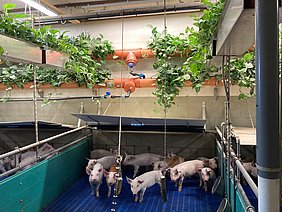A team of scientists from ATB, the Frankenförder Research Association and the Humboldt University of Berlin studied the effect of green plants on the environmental conditions in a piglet house, in particular on the concentration of harmful gases such as ammonia. Green plants in barns could help reduce high ammonia concentrations and contribute to creating a comfortable environment for both animals and barn workers. The results were recently published in the journal Atmosphere.
96 percent of anthropogenic ammonia (NH3) emissions in Europe originate from agriculture, 75 % from livestock farming. Barns and slurry stores are seen as particularly critical, because ammonia is mainly released from excrement. Concentrations of NH3 in pig barns can be substantial because the animals are usually kept in ventilated and heated closed barns. Given the risk of chronic and acute respiratory diseases for animals and humans associated with high NH3 concentrations in pig barns, discussions are underway to further reduce the NH3 concentration limits in pig barns (to 7 ppm for humans and 11 ppm for animals)..
In addition to structural measures such as soil design, improved slurry management and a targeted nutrition strategy in the sense of efficient protein utilization can contribute to the reduction of pollutant gas emissions. ATB scientists together with the Frankenförder Research Association and the Humboldt University of Berlin have investigated whether greenery in pig barns can also contribute to reducing ammonia concentrations in the barns. Green plants in stables could help reduce high gas concentrations, as they are able to absorb and metabolize pollutants from the air via the stomata of the leaves. Research was part of the EIP project 'Stallgrün'.
The investigations were carried out in a pig farm in Brandenburg under real production conditions. Two homogeneous groups of four-week-old piglets (147 animals each) moved into two separate barn compartments, each with eight pens, for a period of eight weeks in summer. One of the two compartments was planted with 175 ornamental plants (9 different plant species). The plants were planted in prefabricated tubes and hung in two rows above the heating system at a height inaccessible to the animals. The second barn compartment without plants served as a control. For a second trial in winter, the number of plants was increased by 50% to approximately 260.
The plants and associated irrigation increased relative humidity by about 9% in summer-autumn and by 6% in winter. The animals in the greened barn were about 6% heavier after the eight weeks compared to the control. Measured NH3 concentrations were rather low with an hourly average of 6 ppm in both barns, with NH3 emissions in both experiments (summer-autumn and winter) being about 20% lower in the greened barn than in the control. However, this difference was within the range of measurement uncertainty (0.5-1 ppm) at low NH3 concentrations.
"Even though our study does not allow a clear statement regarding the reduction of ammonia concentration, the results have shown that in existing housing systems, green plants have a positive influence on the overall housing environment for the animals," explains ATB scientist Dr. Martina Jakob. "To be able to further pursue this approach, the research focus should in future be more on the influence of the individual plants as well as suitable plant species, with air temperature and humidity, ventilation rate, air dust or even the type of plant substrate also being decisive factors," says Martina Jakob.
The EIP Project „Innovative Stallbegrünungssysteme in der Tierhaltung zur Verbesserung des Tier- und Umweltschutzes" (StallGrün) was coordinated by Frankenförder Forschungsgesellschaft mbH. The project was funded by the Ministry of Rural Development, Environment and Agriculture of the State of Brandenburg from the European Innovation Partnership "Agricultural Productivity and Sustainability" (EIP-AGRI). EIP-AGRI projects are funded through the H2020 framework program and from the European Agricultural Fund for Rural Development (EAFRD).
Original publication (open access)
Menardo S, Berg W, Grüneberg H, Jakob M. (2021) Can Green Plants Mitigate Ammonia Concentration in Piglet Barns? Atmosphere 12(9): 1150 https://doi.org/10.3390/atmos12091150
Contact ATB: Dr. Martina Jakob

